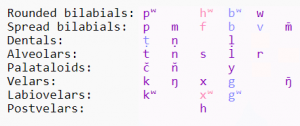Middlesex: Difference between revisions
Poswob Rare (talk | contribs) |
Poswob Rare (talk | contribs) |
||
| Line 55: | Line 55: | ||
<div style="clear: both"></div> | <div style="clear: both"></div> | ||
====Idiolectal variation==== | ====Idiolectal variation==== | ||
Women pronounced ''hʷ~bʷ'' as /hʷ/ and men pronounced it as /bʷ/. WOmen pronounced ''f~b'' as /f/ and men pronounced it as /b/. | |||
;Symmetrical variations | |||
Women pronounced ''hʷ~bʷ'' as /hʷ/ and men pronounced it as /bʷ/. WOmen pronounced ''f~b'' as /f/ and men pronounced it as /b/. Women pronounced ''xʷ~gʷ'' as /xʷ/ and men pronounced it as /gʷ/. | |||
;Female mergers | |||
Women pronounced ''ṭ g v'' as /kʷ x f/. | |||
In a few words, /s/ was hʷ before /a/ for women (thgese words had /o/ for men). | |||
===Vowels=== | ===Vowels=== | ||
Revision as of 13:07, 12 May 2021
The Middlesex language was the common speech register of the early Crystals, used in written communication. Men and women pronounced the words differently, and in their spoken language, they also used different vocabulary and syntax that were not written down except in quotations. Children also had their own speech register.
Evolution
Tapilula (0) to Star Empire Amade (1900)
It is possible that a branch of this family ends up in Kxesh; see Gold_Empire#Migration. Despite the Stars' homeland being described as Lobexon, it is likely that most migrants were from Amade.
- Accented schwas surrendered their accent to the following vowel (not the same as a stress shift, because the tone also changes).
- The "labial" vowel ə disappeared, syllabified nearby consonants or turned to i if the nearby consonants were not possible to become syllabic. Note that it never occurred after labialized consonants. Sequences such as /kəh hək/ (that is, in either original order) collapsed to form aspirated consonants, though these behaved as clusters.
- Tautosyllabic vowel sequences òi ài èi converged to ē. This did not affect syllable-straddling words like /tùya/. Likewise, èu àu òu in the same environment converged to ō.
- In some cases, the result of ài may instead be a short o, due to memories of a still-active morpheme compounding process.
- Duplicate vowel sequences àa èe ìi òo ùu shifted to long vowels ā ē ī ō ū. But the same sequences with the opposite tone pattern did not shift.
- The sequences ṁg ṅg ŋ̇g shifted to ṁb ṅd ŋ̇ġ.
- The velar fricatives g gʷ shifted to Ø w.
- The labial stops p b merged as b.
- In a closed syllable, the stops b t d shifted to w Ø Ø and lengthened the preceding vowel. New ēw āw ōw merged as ō, while new īw ūw merged as ū.
- Word-final ḳ became k. Word-final h spread across the preceding vowel; in other clusters, the /h/ transposed across the syllable boundary to form an aspirated consonant. (This is a general shift that had occurred near the beginning of the history, but it needed to happen again due to compounding.)
- The sequences bh dh shifted to p t.
- The labialized consonants tʷ dʷ nʷ shifted to kʷ v m.
- The labial fricative f shifted to h.
- The velar ejective ḳ shifted to g.
- Before a hiatus, the short vowels u i shifted to ʷ y, creating a new set of labialized consonants. However, the palatalized consonants were not distinct from their components.
- The sequences tʲ nʲ dʲ lʲ shifted to č ň ž y. Then kʲ ŋʲ hʲ shifted to č ň š. Palatalized labials depalatalized.
Thus the consonant inventory was
PLAIN LABIALIZED
Bilabials: p m b v pʷ mʷ bʷ w Alveolars: t n d l tʷ nʷ dʷ lʷ Palataloids: č ň š ž y Velars: k ŋ h g (Ø) kʷ ŋʷ hʷ gʷ
And the vowels were /a e i o u ā ē ī ō ū/.
Star Empire Crystal (1900) to Middlesex Baeba Crystal (3370)
- The voiceless fricatives h hʷ shifted to x h.
- The fricatives d dʷ ž shifted to r w y.
- Then the postalveolar fricative š (including underlying /sʲ/) shifted to s. This change operated on the surface level, meaning that, for example, men's realization of /si/ was still [si], not [sʲi] as one would expect from the pattern set by the stops.
- The consonant clusters ll nn, which occurred primarily in loanwords, shifted to ḷ ṇ.
- The labialized coronals nʷ lʷ shifted to ṇ ḷ.
- The nasals mʷ ŋʷ shifted to m̄ ŋ̄.
Both men and women had a three-vowel surface inventory of /a i u/, but because they had shifted the inherited /a e i o u/ to three vowels in different ways, none of the vowel changes were part of the shared language, and thus none were represented in the orthography. And because the consonant changes were all unconditional, the parent language spellings were all still understandable to the Crystals, and all changes in the preceding 1500 years could be attributed to spelling. Thus Crystal scholars sometimes considered their language to have been unchanged for the preceding 1900 years.[1]
Phonology
Consonant inventory
The written language consonant inventory was
Idiolectal variation
- Symmetrical variations
Women pronounced hʷ~bʷ as /hʷ/ and men pronounced it as /bʷ/. WOmen pronounced f~b as /f/ and men pronounced it as /b/. Women pronounced xʷ~gʷ as /xʷ/ and men pronounced it as /gʷ/.
- Female mergers
Women pronounced ṭ g v as /kʷ x f/.
In a few words, /s/ was hʷ before /a/ for women (thgese words had /o/ for men).
Vowels
Middlesex writing used a five-vowel script, but both men and women used a three vowel inventory, /a i u/, in their speech. The five vowel symbols were needed to tell apart which words varied by gender and which did not.
Notes
- ↑ not 1500, because they used a different start date.
